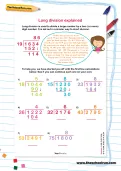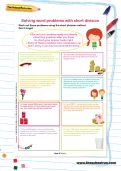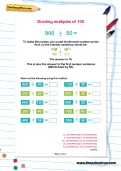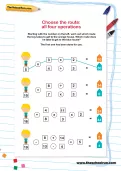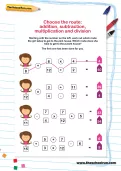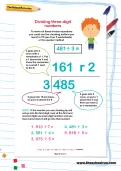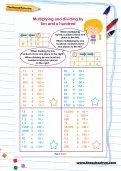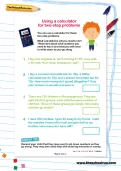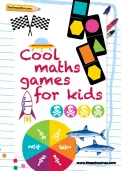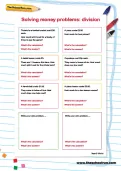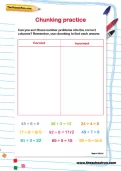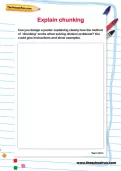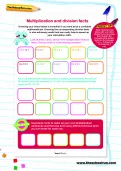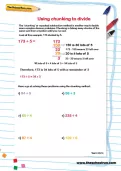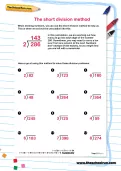Starting with the number on the left, work out which route the boy takes to get to the orange house. Which route does he take to get to the blue house?
or
Register to add to your saved resources
Already a subscriber? to view this content.
Starting with the number on the left, work out which route the girl takes to get to the pink house. Which route does she take to get to the purple house?
or
Register to add to your saved resources
Already a subscriber? to view this content.
To work out these division questions you could use the chunking method you learnt in Y5 (see Year 5 worksheets) or this quicker method. See is you can use this method to answer these tricky division questions.
or
Register to add to your saved resources
Already a subscriber? to view this content.
When multiplying by ten, numbers move one place to the left. When multiplying by one hundred, numbers move two places to the left. When dividing by ten, numbers move one place to the right. When dividing by one hundred, numbers move two places to the right. Use this method to work out the answers to these questions.
or
Register to add to your saved resources
Already a subscriber? to view this content.
When dividing multiples of 100 it can be easier to divide each number by ten first. Can you work out these sums using this method?
or
Register to add to your saved resources
You can use a calculator for these two-step problems. What calculations will you need to do? Think hard about what numbers you need to key in and what you will need to write down as you go along.
or
Register to add to your saved resources
Already a subscriber? to view this content.
Add an extra learning dimension to family game time – try one of our Cool Maths board games and help reinforce your child's knowledge of number bonds, percentages and fractions while you play. Compiled by deputy headteacher Matt Revill and packed with 20 games, this maths learning pack covers all the key skills your child will need to master as part of the primary numeracy curriculum.
or
Register to add to your saved resources
Already a subscriber? to view this content.
Help your child improve their division skills by solving the money word problems on this worksheet. Can they come up with two more of their own?
or
Register to add to your saved resources
Already a subscriber? to view this content.
A worksheet to encourage your child to use their knowledge of chunking when dividing in order to work out whether a number sentence is correct or not.
or
Register to add to your saved resources
Already a subscriber? to view this content.
Encourage your child to revise their knowledge of the chunking method by designing a poster to explain it. Can they think of some examples to illustrate this technique?
or
Register to add to your saved resources
Already a subscriber? to view this content.
This worksheet sets out the relationship between multiplication and division.
or
Register to add to your saved resources
Already a subscriber? to view this content.
This worksheet gives lots of examples of multiplication number sentences for children to try. They are then encouraged to make the connection between multiplication and division.
or
Register to add to your saved resources
Already a subscriber? to view this content.
Chunking, or repeated subtraction, is a way to tackle complex division problems. This worksheet offers a step-by-step guide to the technique and some calculations to practise it on.
or
Register to add to your saved resources
Already a subscriber? to view this content.
This worksheet helps your child learn to set out their calculation using the long division method, then use it to solve division problems.
or
Register to add to your saved resources
Already a subscriber? to view this content.
From sharing and grouping to shorthand division and chunking, this is your step-by-step guide to how your child will be taught to divide numbers in KS2.
or
Register to add to your saved resources
Already a subscriber? to view this content.
